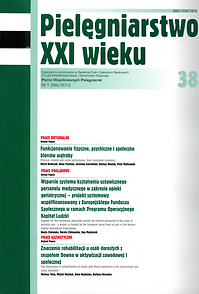Every day activities and gait quality in patients after total hip arthroplasty
Keywords:
total hip arthroplasty, coxarthrosis, pain, gait, daily activitiesAbstract
EVERY DAY ACTIVITIES AND GAIT QUALITY IN PATIENTS AFTER TOTAL HIP ARTHROPLASTY
Aim. The aim of this study was evaluation of daily living activity and of gait in patients after total hip arthroplasty.
Material and methods.The study comprised 100 persons after total hip replacement surgery. The evaluation of effectiveness of operation was carried out on the basis of the inquiry prepared by the authors.
Results. Before operation as much as 65% of patients each day felt hip pain. This pain made it impossible to perform many of daily activities. About 75% of patients had difficulties with such activities as: walking, going upstairs and downstairs, sitting, getting up from the bed, coming in and out the car, washing oneself in the bath, putting on the socks and the shoes and lacing the shoes.After operation in 61% patients the pain made it possible to perform their work and the majority of above mentioned difficulties of daily living was decreased. Before arthroplasty majority of patients walked with stick and limped markedly.Due to the operation percentage of persons, who walked without orthopedic equipment was significant increased.
Conclusions. According to majority of patients the hip arthroplasty improved their motor activity . Increased self- independence in activities of daily living and in gait was noticed.
References
1. Łapaj Ł i wsp. Jakość życia u chorych przed i po endoprotezoplastyce stawu biodrowego. Chirurgia Narządów Ruchu i Ortopedia Polska 2007. 72(4): 269-274.
2. McMurray A et al. Health-Related Quality of Life and health service use following total hip replacement surgery. J. Adv. Nurs. 2002. 40(6): 663-672.
3. Rocławski M, Lorczyński A, Bieniecki M. Ocena wpływu alloplastyki stawu biodrowego na jakość życia uwarunkowaną stanem zdrowia. Chirurgia Narządów Ruchu i Ortopedia Polska 2008. 73(1): 5-9.
4. Skolimowska B, Barczyk K, Mraz M. Kształtowanie się parametrów czynnościowych kończyn dolnych kobiet z koksartrozą po wszczepieniu endoprotezy stawu biodrowego. Fizjoterapia 2005. 1(13): 39-47.
5. Badura-Brzoza K. Wpływ czynników psychicznych i socjodemograficznych na jakość życia chorych poddanych zabiegowi endoprotezoplastyki stawu biodrowego. Psychiatria Polska 2008. 42(2): 261-269.
6. Bentroth R, Gawande S. Patient-reported health status in total joint replacement. J. Arthroplasty 1999. 14, 576-581.
7. Jones CA, Voaklander DC, Johnston WC. The effect of age on pain, function and quality of life after total hip and knee arthroplasty. Arch. Intern. Med. 2001. 12: 454-460.
8. Kokoszka Z. i wsp. Ocena odległych wyników endoprotezoplastyki stawu biodrowego protezą bezcementową typu Zweymüller. Chirurgia Narządów Ruchu i Ortopedia Polska 2008. 73(2): 94-100.
9. Harwood RH, Ebrahim S. A comparison of the responsiveness of the Nottingham extended activities of daily living scale. London handicap scale and SF-36. Disabil. Rehabil. 2000. 22, 786-792.
10. Jachimowicz-Wołoszynek D, Rość D, Michalska A. Wpływ wszczepienia sztucznego stawu biodrowego na jakość życia chorych z chorobą zwyrodnieniową stawu biodrowego. Ortopedia Traumatologia Rehabilitacja 2003. 5(4): 518-526.
11. Starowicz A. i wsp. Ocena jakości życia u pacjentów po operacji wszczepienia endoprotezy stawu biodrowego. Fizjoterapia Polska 2005. 5(3): 313-322.
12. Szydłak D. i wsp. Efekty usprawniania osób po endoprotezoplastyce stawu biodrowego. Annales Academiae Medicae Silesiensis 2008. 62(3-4): 6
Downloads
Published
Issue
Section
License
Copyright (c) 2012 Barbara Borowicz, Małgorzata Cielicka, Anna Nadulska, Mariusz Teter, Mariola Dec-Szlichtyng (Autor)

This work is licensed under a Creative Commons Attribution 4.0 International License.




